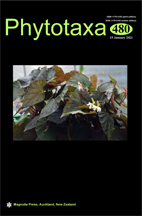CAS Key Laboratory for Plant Diversity and Biogeography of East Asia, Kunming Institute of Botany, Chinese Academy of Sciences, 132 Lanhei Road, Kunming 650201, People’s Republic of China.
Research Center of Microbial Diversity and Sustainable Utilization, Faculty of Science, Chiang Mai University, Chiang Mai, 50200, Thailand.
Department of Plant Medicine, National Chiayi University, 300 Syuefu Road, Chiayi City 60004, Taiwan, People’s Republic of China.
Department of Entomology and Plant Pathology, Faculty of Agriculture, Chiang Mai University, Chiang Mai 50200, Thailand.
Centre of Excellence in Fungal Research, Mae Fah Luang University, Chiang Rai 57100, Thailand.
Faculty of Geology, Geophysics and Environmental Protection, AGH University of Science and Technology, Al. Mickiewicza 30, 30-059 Kraków, Poland.
Centre of Excellence in Fungal Research, Mae Fah Luang University, Chiang Rai 57100, Thailand.
School of Science, Mae Fah Luang University, Chiang Rai 57100, Thailand.
CAS Key Laboratory for Plant Diversity and Biogeography of East Asia, Kunming Institute of Botany, Chinese Academy of Sciences, 132 Lanhei Road, Kunming 650201, People’s Republic of China.
Research Center of Microbial Diversity and Sustainable Utilization, Faculty of Science, Chiang Mai University, Chiang Mai, 50200, Thailand.
World Agroforestry Centre, East and Central Asia, 132 Lanhei Road, Kunming 650201, Yunnan, People’s Republic of China.
Centre for Mountain Futures, Kunming Institute of Botany, Kunming 650201, Yunnan, People’s Republic of China.
Department of Plant Medicine, National Chiayi University, 300 Syuefu Road, Chiayi City 60004, Taiwan, People’s Republic of China.
Research Center of Microbial Diversity and Sustainable Utilization, Faculty of Science, Chiang Mai University, Chiang Mai, 50200, Thailand.
Department of Biology, Faculty of Science, Chiang Mai University, Chiang Mai 50200, Thailand.
CAS Key Laboratory for Plant Diversity and Biogeography of East Asia, Kunming Institute of Botany, Chinese Academy of Sciences, 132 Lanhei Road, Kunming 650201, People’s Republic of China.
Research Center of Microbial Diversity and Sustainable Utilization, Faculty of Science, Chiang Mai University, Chiang Mai, 50200, Thailand.
World Agroforestry Centre, East and Central Asia, 132 Lanhei Road, Kunming 650201, Yunnan, People’s Republic of China.
Centre for Mountain Futures, Kunming Institute of Botany, Kunming 650201, Yunnan, People’s Republic of China.
Research Center of Microbial Diversity and Sustainable Utilization, Faculty of Science, Chiang Mai University, Chiang Mai, 50200, Thailand.
Academy of Science, The Royal Society of Thailand, Bangkok 10300, Thailand.

